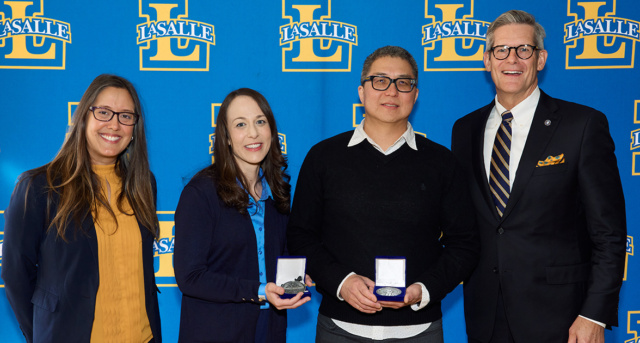La Salle University

Interpretation: English/Spanish—Spanish/English Certificate
- Certificate
- On Campus
What You’ll learn
The curriculum for the Certificate in Interpretation (CII) is designed to address three of the principal environments where interpretation (English-Spanish and Spanish-English) is currently needed and will be more intensely needed in the future: legal, healthcare, and business environments. In addition, governing interpretation principles are also studied for application to language environments covered and not covered by the program.
Why Study English/Spanish Interpretation at La Salle?
Spanish is spoken by more than 559 million people worldwide. A major in Spanish will open the worlds of all major industries such as business, healthcare, law, government, and education. Globally, effective written and oral communication with Spanish speakers is critically important as it is spoken in nineteen Latin American Countries, Spain, Equatorial Guinea, Western Sahara, Philippines, Andorra, and Gibraltar. Not only is Spanish one of the six working languages of the United Nations, but according to Pew Research, over 50% of the households in the United States will speak Spanish by 2050.The Hispanic Institute at La Salle University was founded in 2005 by Dr. Luis A. Gómez. The purpose of the Institute is to offer professional academic programs that provide bilingual and bicultural education to all professionals serving the Hispanic communities throughout the region and the nation.
Highlighted Courses
BLS 614 – Legal Interpretation
Students are introduced to the procedures in criminal and civil law, legal language, the courtroom, and the Interpreter’s Code of Ethics. Practice in the classroom strives to recreate the most common scenarios in which legal interpreting takes place while developing the interpreting skills needed to work as a court interpreter. Students refine their note-taking skills, and special attention is given to develop stamina and maintain concentration while under stress in the courtroom.
BLS 615 – Health-care Interpretation
This course provides information on the health-care system in the United States, medical terminology, code of ethics for medical interpreters, and use of interpreters in health-care situations.
BLS 616 – Business Interpretation
This course introduces simultaneous interpreting with text, so that students learn to use visual or written materials appropriately to enhance their accuracy and completeness when interpreting. Conference interpreting is practiced in class, with students carrying on research and preparation for “conferences,” including compilations of glossaries and topic research. A code of ethics for conference interpreters is discussed, as well as booth etiquette.
BLS 617: Technology in Translation and Interpretation
This course analyzes current tools to enhance and speed up the translation process. These tools include word processors as well as CAT (computer-assisted translation), voice-recognition, and proofreading tools.
Meet the Faculty
Upon graduation, you’ll have honed your written and verbal skills to be able to use them in the workplace. Our faculty members not only train you for your specific field but place you in real-life scenarios to learn collaborative and interpersonal skills, professionalism, and diligence.
Career Opportunities
The median annual wage for interpreters and translators was $49,110 in May 2021.
Employment of interpreters and translators is projected to grow 20 percent from 2021 to 2031, much faster than the average for all occupations.
About 9,200 openings for interpreters and translators are projected each year, on average, over the decade. Many of those openings are expected to result from the need to replace workers who transfer to different occupations or exit the labor force, such as to retire.

La Salle accounting and finance major Hammed Fofana, ‘25, is channeling ambition and experience into career capital.

As part of its annual Mission and Heritage Week celebration, La Salle University proudly recognized two outstanding members of its community with 2025 Distinguished Lasallian Educator Awards on April 9, 2025.

The 2025 Day of Giving raised the most money of all 12 Days of Giving to date, reaching more than $1.9 million in support of La Salle students.